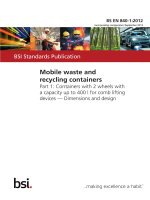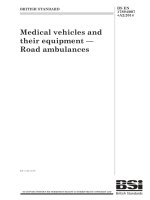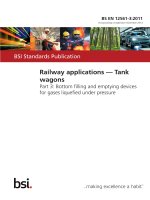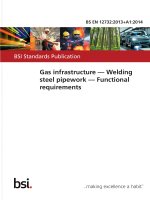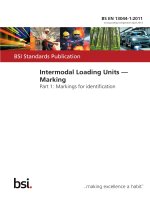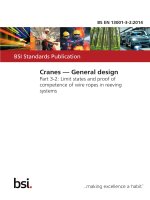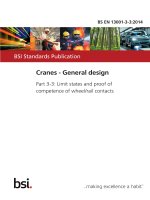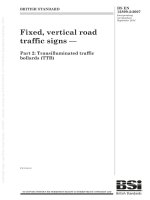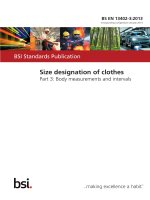Bsi bs en 16603 60 20 2014
Bạn đang xem bản rút gọn của tài liệu. Xem và tải ngay bản đầy đủ của tài liệu tại đây (1.65 MB, 88 trang )
BS EN 16603-60-20:2014
BSI Standards Publication
Space engineering — Star
sensor terminology and
performance specification
BS EN 16603-60-20:2014
BRITISH STANDARD
National foreword
This British Standard is the UK implementation of EN
16603-60-20:2014.
The UK participation in its preparation was entrusted to Technical
Committee ACE/68, Space systems and operations.
A list of organizations represented on this committee can be
obtained on request to its secretary.
This publication does not purport to include all the necessary
provisions of a contract. Users are responsible for its correct
application.
© The British Standards Institution 2014. Published by BSI Standards
Limited 2014
ISBN 978 0 580 84092 0
ICS 49.140
Compliance with a British Standard cannot confer immunity from
legal obligations.
This British Standard was published under the authority of the
Standards Policy and Strategy Committee on 30 September 2014.
Amendments issued since publication
Date
Text affected
BS EN 16603-60-20:2014
EN 16603-60-20
EUROPEAN STANDARD
NORME EUROPÉENNE
EUROPÄISCHE NORM
September 2014
ICS 49.140
English version
Space engineering - Star sensor terminology and performance
specification
Ingénierie spatiale - Specification des performances et
terminolodie des senseurs stellaires
Raumfahrttechnik - Terminologie und
Leistungsspezifikation für Sternensensoren
This European Standard was approved by CEN on 1 March 2014.
CEN and CENELEC members are bound to comply with the CEN/CENELEC Internal Regulations which stipulate the conditions for giving
this European Standard the status of a national standard without any alteration. Up-to-date lists and bibliographical references concerning
such national standards may be obtained on application to the CEN-CENELEC Management Centre or to any CEN and CENELEC
member.
This European Standard exists in three official versions (English, French, German). A version in any other language made by translation
under the responsibility of a CEN and CENELEC member into its own language and notified to the CEN-CENELEC Management Centre
has the same status as the official versions.
CEN and CENELEC members are the national standards bodies and national electrotechnical committees of Austria, Belgium, Bulgaria,
Croatia, Cyprus, Czech Republic, Denmark, Estonia, Finland, Former Yugoslav Republic of Macedonia, France, Germany, Greece,
Hungary, Iceland, Ireland, Italy, Latvia, Lithuania, Luxembourg, Malta, Netherlands, Norway, Poland, Portugal, Romania, Slovakia,
Slovenia, Spain, Sweden, Switzerland, Turkey and United Kingdom.
CEN-CENELEC Management Centre:
Avenue Marnix 17, B-1000 Brussels
© 2014 CEN/CENELEC All rights of exploitation in any form and by any means reserved
worldwide for CEN national Members and for CENELEC
Members.
Ref. No. EN 16603-60-20:2014 E
BS EN 16603-60-20:2014
EN 16603-60-20:2014 (E)
Table of contents
Foreword .................................................................................................................... 5
Introduction................................................................................................................ 6
1 Scope ....................................................................................................................... 7
2 Normative references ............................................................................................. 8
3 Terms, definitions and abbreviated terms............................................................ 9
3.1
Terms from other standards......................................................................................9
3.2
Terms specific to the present standard .....................................................................9
3.3
Abbreviated terms...................................................................................................28
4 Functional requirements ...................................................................................... 30
4.1
4.2
4.3
4.4
Star sensor capabilities ...........................................................................................30
4.1.1
Overview ...................................................................................................30
4.1.2
Cartography ..............................................................................................31
4.1.3
Star tracking ..............................................................................................32
4.1.4
Autonomous star tracking.......................................................................... 32
4.1.5
Autonomous attitude determination ........................................................... 33
4.1.6
Autonomous attitude tracking .................................................................... 34
4.1.7
Angular rate measurement ........................................................................ 34
4.1.8
(Partial) image download........................................................................... 35
4.1.9
Sun survivability ........................................................................................35
Types of star sensors .............................................................................................36
4.2.1
Overview ...................................................................................................36
4.2.2
Star camera ..............................................................................................36
4.2.3
Star tracker ...............................................................................................36
4.2.4
Autonomous star tracker ........................................................................... 36
Reference frames ...................................................................................................37
4.3.1
Overview ...................................................................................................37
4.3.2
Provisions .................................................................................................37
On-board star catalogue .........................................................................................37
5 Performance requirements .................................................................................. 39
2
BS EN 16603-60-20:2014
EN 16603-60-20:2014 (E)
5.1
5.2
Use of the statistical ensemble ...............................................................................39
5.1.1
Overview ...................................................................................................39
5.1.2
Provisions .................................................................................................39
Use of simulations in verification methods .............................................................. 40
5.2.1
Overview ...................................................................................................40
5.2.2
Provisions for single star performances..................................................... 40
5.2.3
Provisions for quaternion performances .................................................... 40
5.3
Confidence level .....................................................................................................40
5.4
General performance conditions .............................................................................41
5.5
General performance metrics .................................................................................42
5.5.1
Overview ...................................................................................................42
5.5.2
Bias ...........................................................................................................42
5.5.3
Thermo elastic error ..................................................................................43
5.5.4
FOV spatial error .......................................................................................44
5.5.5
Pixel spatial error ......................................................................................45
5.5.6
Temporal noise .........................................................................................45
5.5.7
Aberration of light ......................................................................................46
5.5.8
Measurement date error ............................................................................ 47
5.5.9
Measured output bandwidth ...................................................................... 47
5.6
Cartography ............................................................................................................47
5.7
Star tracking ...........................................................................................................47
5.8
5.9
5.7.1
Additional performance conditions ............................................................ 47
5.7.2
Single star tracking maintenance probability ............................................. 48
Autonomous star tracking .......................................................................................48
5.8.1
Additional performance conditions ............................................................ 48
5.8.2
Multiple star tracking maintenance level .................................................... 48
Autonomous attitude determination ........................................................................ 49
5.9.1
General .....................................................................................................49
5.9.2
Additional performance conditions ............................................................ 49
5.9.3
Verification methods..................................................................................50
5.9.4
Attitude determination probability .............................................................. 50
5.10 Autonomous attitude tracking .................................................................................51
5.10.1
Additional performance conditions ............................................................ 51
5.10.2
Maintenance level of attitude tracking ....................................................... 52
5.10.3
Sensor settling time...................................................................................53
5.11 Angular rate measurement .....................................................................................53
5.11.1
Additional performance conditions ............................................................ 53
3
BS EN 16603-60-20:2014
EN 16603-60-20:2014 (E)
5.11.2
Verification methods..................................................................................53
5.12 Mathematical model................................................................................................54
Bibliography............................................................................................................. 84
Figures
Figure 3-1: Star sensor elements – schematic ...................................................................... 12
Figure 3-2: Example alignment reference frame ................................................................... 14
Figure 3-3: Boresight reference frame ..................................................................................15
Figure 3-4: Example of Inertial reference frame .................................................................... 15
Figure 3-5: Mechanical reference frame ...............................................................................16
Figure 3-6: Schematic illustration of reference frames .......................................................... 17
Figure 3-7: Stellar reference frame .......................................................................................17
Figure 3-8: Schematic timing diagram ..................................................................................19
Figure 3-9: Field of View.......................................................................................................21
Figure 3-10: Aspect angle to planetary body or sun.............................................................. 22
Figure 4-1: Schematic generalized Star Sensor model ......................................................... 31
Figure B-1 : AME, MME schematic definition........................................................................ 61
Figure B-2 : RME Schematic Definition ................................................................................62
Figure B-3 : MDE Schematic Definition ................................................................................63
Figure B-4 : Rotational and directional Error Geometry ........................................................ 64
Figure F-1 : Angle rotation sequence....................................................................................79
Figure H-1 : Example of detailed data sheet ......................................................................... 83
Tables
Table C-1 : Minimum and optional capabilities for star sensors ............................................ 69
Table D-1 : Measurement error metrics ................................................................................71
Table D-2 : Star Position measurement error metrics ........................................................... 71
Table E-1 : Minimum number of simulations to verify a performance at performance
confidence level PC to an estimation confidence level of 95 % ........................... 76
Table G-1 : Contributing error sources .................................................................................80
4
BS EN 16603-60-20:2014
EN 16603-60-20:2014 (E)
Foreword
This document (EN 16603-60-20:2014) has been prepared by Technical
Committee CEN/CLC/TC 5 “Space”, the secretariat of which is held by DIN.
This standard (EN 16603-60-20:2014) originates from ECSS-E-ST-60-20C Rev. 1.
This European Standard shall be given the status of a national standard, either
by publication of an identical text or by endorsement, at the latest by March
2015, and conflicting national standards shall be withdrawn at the latest by
March 2015.
Attention is drawn to the possibility that some of the elements of this document
may be the subject of patent rights. CEN [and/or CENELEC] shall not be held
responsible for identifying any or all such patent rights.
This document has been prepared under a mandate given to CEN by the
European Commission and the European Free Trade Association.
This document has been developed to cover specifically space systems and has
therefore precedence over any EN covering the same scope but with a wider
domain of applicability (e.g. : aerospace).
According to the CEN-CENELEC Internal Regulations, the national standards
organizations of the following countries are bound to implement this European
Standard: Austria, Belgium, Bulgaria, Croatia, Cyprus, Czech Republic,
Denmark, Estonia, Finland, Former Yugoslav Republic of Macedonia, France,
Germany, Greece, Hungary, Iceland, Ireland, Italy, Latvia, Lithuania,
Luxembourg, Malta, Netherlands, Norway, Poland, Portugal, Romania,
Slovakia, Slovenia, Spain, Sweden, Switzerland, Turkey and the United
Kingdom.
5
BS EN 16603-60-20:2014
EN 16603-60-20:2014 (E)
Introduction
In recent years there have been rapid developments in star tracker technology,
in particular with a great increase in sensor autonomy and capabilities. This
Standard is intended to support the variety of star sensors either available or
under development.
This Standard defines the terminology and specification definitions for the
performance of star trackers (in particular, autonomous star trackers). It focuses
on the specific issues involved in the specification of performances of star
trackers and is intended to be used as a structured set of systematic provisions.
This Standard is not intended to replace textbook material on star tracker
technology, and such material is intentionally avoided. The readers and users of
this Standard are assumed to possess general knowledge of star tracker
technology and its application to space missions.
This document defines and normalizes terms used in star sensor performance
specifications, as well as some performance assessment conditions:
6
•
sensor components
•
sensor capabilities
•
sensor types
•
sensor reference frames
•
sensor metrics
BS EN 16603-60-20:2014
EN 16603-60-20:2014 (E)
1
Scope
This Standard specifies star tracker performances as part of a space project. The
Standard covers all aspects of performances, including nomenclature,
definitions, and performance metrics for the performance specification of star
sensors.
The Standard focuses on performance specifications. Other specification types,
for example mass and power, housekeeping data, TM/TC interface and data
structures, are outside the scope of this Standard.
When viewed from the perspective of a specific project context, the
requirements defined in this Standard should be tailored to match the genuine
requirements of a particular profile and circumstances of a project.
This standard may be tailored for the specific characteristics and constraints of a
space project in conformance with ECSS-S-ST-00.
7
BS EN 16603-60-20:2014
EN 16603-60-20:2014 (E)
2
Normative references
The following normative documents contain provisions which, through
reference in this text, constitute provisions of this ECSS Standard. For dated
references, subsequent amendments to, or revision of any of these publications,
do not apply. However, parties to agreements based on this ECSS Standard are
encouraged to investigate the possibility of applying the more recent editions of
the normative documents indicated below. For undated references, the latest
edition of the publication referred to applies.
EN reference
Reference in text
Title
EN 16601-00-01
ECSS-S-ST-00-01
ECSS system – Glossary of terms
8
BS EN 16603-60-20:2014
EN 16603-60-20:2014 (E)
3
Terms, definitions and abbreviated terms
3.1
Terms from other standards
For the purpose of this Standard, the terms and definitions from ECSS-S-ST-00-01
apply. Additional definitions are included in Annex B.
3.2
Terms specific to the present standard
3.2.1
Capabilities
3.2.1.1
aided tracking
capability to input information to the star sensor internal processing from an
external source
3.2.1.2
NOTE 1
This capability applies to star tracking,
autonomous star tracking and autonomous
attitude tracking.
NOTE 2
E.g. AOCS.
angular rate measurement
capability to determine, the instantaneous sensor reference frame inertial
angular rotational rates
NOTE
3.2.1.3
Angular rate can be computed from successive star
positions obtained from the detector or successive
absolute attitude (derivation of successive
attitude).
autonomous attitude determination
capability to determine the absolute orientation of a defined sensor reference
frame with respect to a defined inertial reference frame and to do so without
the use of any a priori or externally supplied attitude, angular rate or angular
acceleration information
3.2.1.4
autonomous attitude tracking
capability to repeatedly re-assess and update the orientation of a sensor-defined
reference frame with respect to an inertially defined reference frame for an
extended period of time, using autonomously selected star images in the field
9
BS EN 16603-60-20:2014
EN 16603-60-20:2014 (E)
of view, following the changing orientation of the sensor reference frame as it
moves in space
3.2.1.5
NOTE 1
The Autonomous Attitude Tracking makes use of a
supplied a priori Attitude Quaternion, either
provided by an external source (e.g. AOCS) or as
the output of an Autonomous Attitude
Determination (‘Lost-in-Space’ solution).
NOTE 2
The autonomous attitude tracking functionality
can also be achieved by the repeated use of the
Autonomous Attitude Determination capability.
NOTE 3
The Autonomous Attitude Tracking capability
does not imply the solution of the ‘lost in space’
problem.
autonomous star tracking
capability to detect, locate, select and subsequently track star images within the
sensor field of view for an extended period of time with no assistance external
to the sensor
3.2.1.6
NOTE 1
Furthermore, the autonomous star tracking
capability is taken to include the ability to
determine when a tracked image leaves the sensor
field of view and select a replacement image to be
tracked without any user intervention.
NOTE 2
See also 3.2.1.9 (star tracking).
cartography
capability to scan the entire sensor field of view and to locate and output the
position of each star image within that field of view
3.2.1.7
image download
capability to capture the signals from the detector over the entire detector Field
of view, at one instant (i.e. within a single integration), and output all of that
information to the user
NOTE
3.2.1.8
See also 3.2.1.8 (partial image download).
partial image download
capability to capture the signals from the detector over the entire detector Field
of view, at one instant (i.e. within a single integration), and output part of that
information to the user
10
NOTE 1
Partial image download is an image downloads
(see 3.2.1.7) where only a part of the detector field
of view can be output for any given specific
‘instant’.
NOTE 2
Partial readout of the detector array (windowing)
and output of the corresponding pixel signals also
fulfil the functionality.
BS EN 16603-60-20:2014
EN 16603-60-20:2014 (E)
3.2.1.9
star tracking
capability to measure the location of selected star images on a detector, to
output the co-ordinates of those star images with respect to a sensor defined
reference frame and to repeatedly re-assess and update those co-ordinates for
an extended period of time, following the motion of each image across the
detector
3.2.1.10
sun survivability
capability to withstand direct sun illumination along the boresight axis for a
certain period of time without permanent damage or subsequent performance
degradation
NOTE
This capability could be extended to flare
capability considering the potential effect of the
earth or the moon in the FOV.
3.2.2
Star sensor components
3.2.2.1
Overview
Figure 3-1 shows a scheme of the interface among the generalized components
specified in this Standard.
NOTE
Used as a camera the sensor output can be located
directly after the pre-processing block.
11
BS EN 16603-60-20:2014
EN 16603-60-20:2014 (E)
BAFFLE
OPTICAL
HEAD
OPTICAL SYSTEM
DETECTOR
PRE-PROCESSING
PROCESSOR
MEMORY
CAMERA
OUTPUT
PROCESS OUPUT
Figure 3-1: Star sensor elements – schematic
3.2.2.2
baffle
passive structure used to prevent or reduce the entry into the sensor lens or
aperture of any signals originating from outside of the field of view of the
sensor
NOTE
3.2.2.3
Baffle design is usually mission specific and
usually determines the effective exclusion angles
for the limb of the Earth, Moon and Sun. The Baffle
can be mounted directly on the sensor or can be a
totally separate element. In the latter case, a
positioning specification with respect to the sensor
is used.
detector
element of the star sensor that converts the incoming signal (photons) into an
electrical signal
NOTE
12
Usual technologies in use are CCD (charge
coupled device) and APS (active pixel sensor)
BS EN 16603-60-20:2014
EN 16603-60-20:2014 (E)
arrays though photomultipliers and various other
technologies can also be used.
3.2.2.4
electronic processing unit
set of functions of the sensor not contained within the optical head
NOTE
Specifically, the sensor electronics contains:
• sensor processor;
• power conditioning;
• software algorithms;
• onboard star catalogue (if present).
3.2.2.5
optical head
part of the sensor responsible for the capture and measurement of the incoming
signal
NOTE
As such it consists of
• the optical system;
• the detector (including any cooling equipment);
• the proximity electronics (usually detector
control, readout and interface, and optionally
pixel pre-processing);
• the mechanical structure to support the above.
3.2.2.6
optical system
system that comprises the component parts to capture and focus the incoming
photons
NOTE
Usually this consists of a number of lenses, or
mirrors and filters, and the supporting mechanical
structure, stops, pinholes and slits if used.
3.2.3
Reference frames
3.2.3.1
alignment reference frame (ARF)
reference frame fixed with respect to the sensor external optical cube where the
origin of the ARF is defined unambiguously with reference to the sensor
external optical cube
NOTE 1
The X-, Y- and Z-axes of the ARF are a righthanded orthogonal set of axes which are defined
unambiguously with respect to the normal of the
faces of the external optical cube. Figure 3-2
schematically illustrates the definition of the ARF.
NOTE 2
The ARF is the frame used to align the sensor
during integration.
NOTE 3
This definition does not attempt to prescribe a
definition of the ARF, other than it is a frame fixed
relative to the physical geometry of the sensor
optical cube.
13
BS EN 16603-60-20:2014
EN 16603-60-20:2014 (E)
NOTE 4
If the optical cube’s faces are not perfectly
orthogonal, the X-axis can be defined as the
projection of the normal of the X-face in the plane
orthogonal to the Z-axis, and the Y-axis completes
the RHS.
ZARF
YARF
XARF
Sensor
Optical
Cube
Figure 3-2: Example alignment reference frame
3.2.3.2
boresight reference frame (BRF)
reference frame where:
•
the origin of the Boresight Reference Frame (BRF)
is defined
unambiguously with reference to the mounting interface plane of the
sensor Optical Head;
NOTE
14
In an ideally aligned opto-electrical system this
results in a measured position at the centre of the
detector.
•
the Z-axis of the BRF is defined to be anti-parallel to the direction of an
incoming collimated light ray which is parallel to the optical axis;
•
X-BRF-axis is in the plane spanned by Z-BRF-axis and the vector from
the detector centre pointing along the positively counted detector rows,
as the axis perpendicular to Z-BRF-axis. The Y-BRF-axis completes the
right handed orthogonal system.
NOTE 1
The X-axes and Y-axes of the BRF are defined to lie
(nominally) in the plane of the detector
perpendicular to the Z-axis, so as to form a right
handed set with one axis nominally along the
detector array row and the other nominally along
the detector array column. Figure 3-3 schematically
illustrates the definition of the BRF.
NOTE 2
The definition of the Boresight Reference Frame
does not imply that it is fixed with respect to the
BS EN 16603-60-20:2014
EN 16603-60-20:2014 (E)
Detector, but that it is fixed with respect to the
combined detector and optical system.
Incoming light ray that
will give a measured
position at the centre of
the Detector.
ZBRF
Optics
YBRF
Detector
XBRF
Figure 3-3: Boresight reference frame
3.2.3.3
inertial reference frame (IRF)
reference frame determined to provide an inertial reference
NOTE 1
E.g. use the J2000 reference frame as IRF as shown
in Figure 3-4.
NOTE 2
The J2000 reference frame (in short for ICRF – Inertial
Celestial Reference Frame at J2000 Julian date) is
usually defined as Z IRF = earth axis of rotation
(direction of north) at J2000 (01/01/2000 at noon
GMT), X IRF = direction of vernal equinox at J2000,
Y IRF completes the right-handed orthonormal
reference frame.
ZIRF at J2000 Julian date
YIRF
Earth
Ecliptic Plane
ϒ
XIRF
Equatorial Plane
X-axis in direction of
vernal equinox
Figure 3-4: Example of Inertial reference frame
15
BS EN 16603-60-20:2014
EN 16603-60-20:2014 (E)
3.2.3.4
mechanical reference frame (MRF)
reference frame where the origin of the MRF is defined unambiguously with
reference to the mounting interface plane of the sensor Optical Head
NOTE 1
For Fused Multiple Optical Head configurations,
the interface plane of one of the Optical Heads
may be nominated to define the MRF. The
orientation is to be defined.
NOTE 2
E.g. the Z-axis of the MRF is defined to be
perpendicular to the mounting interface plane. The
X- and Y-axes of the MRF are defined to lie in the
mounting plane such as to form an orthogonal
RHS with the MRF Z-axis.
NOTE 3
Figure 3-5 schematically illustrates the definition
of the MRF.
ZMRF
YMRF
Mounting Interface
Spacecraft Body
XMRF
Figure 3-5: Mechanical reference frame
3.2.3.5
stellar reference frame (SRF)
reference frame for each star where the origin of any SRF is defined to be
coincident with the Boresight Reference Frame (BRF) origin
16
NOTE 1
The Z-axis of any SRF is defined to be the direction
from the SRF origin to the true position of the
selected star Figure 3-6 gives a schematic
representation of the reference frames. Figure 3-7
schematically illustrates the definition of the SRF.
NOTE 2
The X- and Y- axes of the SRF are obtained under
the assumption that the BRF can be brought into
coincidence with the SRF by two rotations, the first
around the BRF X-axis and the second around the
new BRF Y-axis (which is coincident with the SRF
Y-axis).
BS EN 16603-60-20:2014
EN 16603-60-20:2014 (E)
ZBRF
ZSRF
ZARF
IRF Axes
Sensor
ZMRF
Optical
Cube
YBRF
XBRF
Mounting Plate
Spacecraft Body
Figure 3-6: Schematic illustration of reference frames
Selected star
ZBRF
ZSRF
2nd rotation
YSRF
YBRF
1st rotation
Detector
XBRF
XSRF
Figure 3-7: Stellar reference frame
17
BS EN 16603-60-20:2014
EN 16603-60-20:2014 (E)
3.2.4
Definitions related to time and frequency
3.2.4.1
integration time
exposure time over which photons were collected in the detector array prior to
readout and processing to generate the output (star positions or attitude)
18
NOTE 1
Integration time can be fixed, manually adjustable
or autonomously set.
NOTE 2
Figure 3-8 illustrates schematically the various
times defined together with their interrelationship. The figure includes data being output
from two Optical Heads, each of which is
separately processed prior to generation of the
sensor output. Note that for a Fused Multiple
Optical Head sensor; conceptually it is assumed
that the filtered output is achieved via sequential
processing of data from a single head at a time as
the data is received.
Hence, with this
understanding, the figure and the associated time
definitions also apply to this sensor configuration.
Time
Latency
OUT
Data is
accessed
Time data is
first available
Output
Data
Flow
Processing
Integration
Optical
Head 1
Optical Head
2
PROCESSING
Integration time
PROCESSING
Sample Time
OUT
BS EN 16603-60-20:2014
EN 16603-60-20:2014 (E)
Figure 3-8: Schematic timing diagram
3.2.4.2
measurement date
date of the provided measurement
NOTE 1
In case of on board filtering the measurement date
can deviate from individual measurement dates.
19
BS EN 16603-60-20:2014
EN 16603-60-20:2014 (E)
NOTE 2
3.2.4.3
Usually the mid-point of the integration time is
considered as measurement date for CCD
technology.
output bandwidth
maximum frequency contained within the sensor outputs
NOTE 1
The bandwidth of the sensor is limited in general
by several factors, including:
• integration time;
• sampling frequency;
• attitude processing rate;
• onboard filtering of data (in particular for
multiple head units).
NOTE 2
The output bandwidth corresponds to the
bandwidth of the sensor seen as a low-pass filter.
3.2.5
Field of view
3.2.5.1
half-rectangular field of view
angular region around the Boresight Reference Frame (BRF) frame Z-axis,
specified by the angular excursions around the BRF X- and Y-axes between the
BRF Z-axis and the appropriate rectangle edge, within which a star produces an
image on the Detector array that is then used by the star sensor
20
NOTE 1
This Field of View is determined by the optics and
Detector design. This is schematically illustrated in
Figure 3-9.
NOTE 2
In the corners, the extent of the FOV for this
definition exceeds the quoted value (see Figure
3-9).
BS EN 16603-60-20:2014
EN 16603-60-20:2014 (E)
Half Rectangular
Field of View
Light cone for
Half-Rectangular
Field of View
BRF Z axis
Light cone for Full
Cone Field of View
Full Cone Field
of View
Detector
Figure 3-9: Field of View
3.2.5.2
full cone field of view
angular region around the Boresight Reference Frame (BRF) frame Z-axis,
specified as a full cone angle, within which a star will produce an image on the
Detector array that is then used by the star sensor
NOTE
3.2.5.3
This Field of View is determined by the optics and
Detector design. This is schematically illustrated in
Figure 3-9.
pixel field of view
angle subtended by a single Detector element
NOTE
Pixel Field of View replaces (and is identical to) the
commonly used term Instantaneous Field of View.
3.2.6
Angles of celestial bodies
3.2.6.1
aspect angle
half-cone angle between the Boresight Reference Frame (BRF) Z-axis and the
nearest limb of a celestial body
21
BS EN 16603-60-20:2014
EN 16603-60-20:2014 (E)
ZBRF
Solar System
Body
MEA
EEA
ASPECT ANGLE
(in plane of diagram)
SEA
Detector
Figure 3-10: Aspect angle to planetary body or sun
3.2.6.2
exclusion angle (EA)
lowest aspect angle of a body at which quoted full performance is achieved
NOTE 1
The following particular exclusion angles can be
considered:
• The Earth exclusion angle (EEA), defined as the
lowest aspect angle of fully illuminated Earth
(including the Earth atmosphere) at which
quoted full performance is achieved, as shown
schematically in Figure 3-10.
• The Sun Exclusion Angle (SEA), defined as the
lowest Aspect Angle of the Sun at which
quoted full performance is achieved, as shown
schematically in Figure 3-10.
• The Moon Exclusion Angle (MEA) is defined as
the lowest Aspect Angle of the Full Moon at
which quoted full performance is achieved, as
shown schematically in Figure 3-10.
NOTE 2
The value of any EA depends on the distance to
the object. In general, the bandwidth is the lowest
of the cut-off frequencies implied by the above
factors.
3.2.7
Most common terms
3.2.7.1
correct attitude
attitude for which the quaternion absolute measurement error (AMEq defined
in D.2.2) is lower than a given threshold
22
BS EN 16603-60-20:2014
EN 16603-60-20:2014 (E)
3.2.7.2
correct attitude threshold
maximum quaternion absolute measurement error (AMEq) for which an
attitude is a correct attitude
3.2.7.3
false attitude
attitude which is a non correct attitude
3.2.7.4
false star
signal on the detector not arising from a stellar source but otherwise
indistinguishable from a star image
NOTE
3.2.7.5
This definition explicitly excludes effects from the
Moon, low incidence angle proton effects etc.,
which can generally be distinguished as non-stellar
in origin by geometry.
image output time
time required to output the detector image
3.2.7.6
statistical ensemble
set of sensors (not all actually built) on which the performances are assessed by
use of statistical tools on a set of observations and observation conditions
3.2.7.7
NOTE 1
The statistical ensemble is defined on a case-bycase basis, depending on the performances to be
assessed.
NOTE 2
See 5.1 and Annex E for further details.
maintenance level of attitude tracking
total time within a longer defined interval that attitude tracking is maintained
(i.e. without any attitude acquisition being performed) with a probability of
100 % for any initial pointing within the celestial sphere
NOTE
3.2.7.8
This parameter can also be specified as Mean Time
between loss of tracking or probability to loose
tracking per time unit.
multiple star tracking maintenance level
total time within a longer defined interval that at least ‘n’ star tracks are
maintained with a probability of 100 %
NOTE
3.2.7.9
This covers the case where the stars in the FOV are
changing, such that the star tracks maintained
evolve with time.
night sky test
test performed during night time using the sky as physical stimulus for the star
sensor. The effect of atmospheric extinction should be taken into account and
reduced by appropriate choice of the location for test
23
